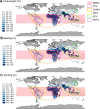Taking a bite out of nutrition and arbovirus infection
- PMID: 29596427
- PMCID: PMC5875747
- DOI: 10.1371/journal.pntd.0006247
Taking a bite out of nutrition and arbovirus infection
Abstract
Nutrition is a key factor in host-pathogen defense. Malnutrition can increase both host susceptibility and severity of infection through a number of pathways, and infection itself can promote nutritional deterioration and further susceptibility. Nutritional status can also strongly influence response to vaccination or therapeutic pharmaceuticals. Arthropod-borne viruses (arboviruses) have a long history of infecting humans, resulting in regular pandemics as well as an increasing frequency of autochthonous transmission. Interestingly, aside from host-related factors, nutrition could also play a role in the competence of vectors required for transmission of these viruses. Nutritional status of the host and vector could even influence viral evolution itself. Therefore, it is vital to understand the role of nutrition in the arbovirus lifecycle. This Review will focus on nutritional factors that could influence susceptibility and severity of infection in the host, response to prophylactic and therapeutic strategies, vector competence, and viral evolution.
Conflict of interest statement
The authors have declared that no competing interests exist.
Figures


Similar articles
-
The role of co-infection and swarm dynamics in arbovirus transmission.Virus Res. 2019 May;265:88-93. doi: 10.1016/j.virusres.2019.03.010. Epub 2019 Mar 14. Virus Res. 2019. PMID: 30879977 Review.
-
The microbiome modulates arbovirus transmission in mosquitoes.Curr Opin Virol. 2015 Dec;15:97-102. doi: 10.1016/j.coviro.2015.08.011. Epub 2015 Sep 11. Curr Opin Virol. 2015. PMID: 26363996 Free PMC article. Review.
-
The insect microbiome modulates vector competence for arboviruses.Viruses. 2014 Nov 11;6(11):4294-313. doi: 10.3390/v6114294. Viruses. 2014. PMID: 25393895 Free PMC article. Review.
-
Tissue Barriers to Arbovirus Infection in Mosquitoes.Viruses. 2015 Jul 8;7(7):3741-67. doi: 10.3390/v7072795. Viruses. 2015. PMID: 26184281 Free PMC article. Review.
-
Insect-specific viruses and their potential impact on arbovirus transmission.Curr Opin Virol. 2015 Dec;15:69-74. doi: 10.1016/j.coviro.2015.08.007. Epub 2015 Aug 31. Curr Opin Virol. 2015. PMID: 26322695 Free PMC article. Review.
Cited by
-
Influenza in obese travellers: increased risk and complications, decreased vaccine effectiveness.J Travel Med. 2019 May 10;26(3):taz020. doi: 10.1093/jtm/taz020. J Travel Med. 2019. PMID: 30924873 Free PMC article. Review.
-
Congenital Zika syndrome is associated with maternal protein malnutrition.Sci Adv. 2020 Jan 10;6(2):eaaw6284. doi: 10.1126/sciadv.aaw6284. eCollection 2020 Jan. Sci Adv. 2020. PMID: 31950075 Free PMC article.
-
Larval crowding enhances dengue virus loads in Aedes aegypti, a relationship that might increase transmission in urban environments.PLoS Negl Trop Dis. 2024 Sep 10;18(9):e0012482. doi: 10.1371/journal.pntd.0012482. eCollection 2024 Sep. PLoS Negl Trop Dis. 2024. PMID: 39255310 Free PMC article.
-
Palmitoleate Protects against Zika Virus-Induced Placental Trophoblast Apoptosis.Biomedicines. 2021 Jun 4;9(6):643. doi: 10.3390/biomedicines9060643. Biomedicines. 2021. PMID: 34200091 Free PMC article.
-
Exploring the Causal Effects of Micronutrient Supplementation on Susceptibility to Viral Pneumonia: A Mendelian Randomization Study.Pathogens. 2025 Mar 7;14(3):263. doi: 10.3390/pathogens14030263. Pathogens. 2025. PMID: 40137748 Free PMC article.
References
-
- Katona P, Katona-Apte J. The Interaction between Nutrition and Infection. Clinical Infectious Diseases. 2008;46(10):1582–8. doi: 10.1086/587658 - DOI - PubMed
-
- World Health Organization. Fact Sheet 311: Obesity 2016 [cited 2017 July 31]. Available from: http://www.who.int/mediacentre/factsheets/fs311/en/.
-
- World Health Organization. Fact sheet: Malnutrition 2017 [cited 2017 31 July]. Available from: http://www.who.int/mediacentre/factsheets/malnutrition/en/.
-
- Chapman IM. Nutritional Disorders in the Elderly. Medical Clinics of North America. 2006;90(5):887–907. doi: 10.1016/j.mcna.2006.05.010 - DOI - PubMed
-
- Disease Control Priorities Project. Eliminating Malnutrition Could Reduce Poor Countries’ Disease Burden by One-Third. 2007.
Publication types
MeSH terms
LinkOut - more resources
Full Text Sources
Other Literature Sources

